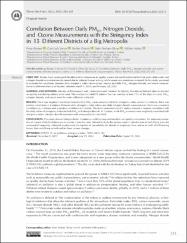| dc.contributor.author | Bostan, Pınar | |
| dc.contributor.author | Yavuz, Cavit Işık | |
| dc.contributor.author | Öztürk, Berker | |
| dc.contributor.author | Olcay, Sabri Serhan | |
| dc.contributor.author | Aykaç, Nilüfer | |
| dc.date.accessioned | 2023-10-04T06:55:22Z | |
| dc.date.available | 2023-10-04T06:55:22Z | |
| dc.date.issued | 2023 | en_US |
| dc.identifier.citation | Bostan P, Yavuz CI, Öztürk B, Olcay SS, Aykaç N. Correlation between daily PM 10 , nitrogen dioxide, and ozone
measurements with the stringency index in 15 different districts of a big metropolis. Thorac Res Pract. 2023;24(5):253-261. | en_US |
| dc.identifier.issn | 29799139 | |
| dc.identifier.uri | https://hdl.handle.net/20.500.12809/11002 | |
| dc.description.abstract | OBJECTIVE: Studies have investigated the effects of lockdowns on air quality around the world and found that fine particulate matter and nitrogen dioxide concentrations decreased due to reduced human activity, while ozone concentrations increased. In this study, we aimed to evaluate the correlation between daily stringency index values of our country and daily PM10, nitrogen dioxide, and ozone measurements in different districts of Istanbul between March 1, 2020, and February 28, 2022. MATERIAL AND METHODS: Ministry of Environment and Urbanization and National Air Quality Monitoring Network data on Istanbul air quality monitoring stations were used. The analysis included 15 stations that can monitor at least 75% of the days in a year. PM10, nitrogen dioxide, and ozone were the main pollutants analyzed. RESULTS: There was negative correlation between daily PM10 measurements and daily stringency index values in 3 stations; there was positive correlation in 6 stations. Between daily stringency index values and daily nitrogen dioxide measurements, there was a negative correlation in 3 stations and a positive correlation in 1 station. The daily measurements of 1 station showed a negative correlation with the daily values of stringency index for both PM10 and nitrogen dioxide. In 1 station, while PM10 measures were negatively correlated with stringency index, nitrogen dioxide measurements were positively correlated. CONCLUSION: This study showed that pandemic limitations could not improve Istanbul’s air quality everywhere. For adequate evaluation of impact of the limitations on air quality, it may be more relevant to study the socioeconomic infrastructure of each living area, the sociospatial inequality, industrial employment, the number of households, the density of employee class, and so on with all influencing factors that could have contributed to these various changes. | en_US |
| dc.item-language.iso | eng | en_US |
| dc.publisher | AVES | en_US |
| dc.relation.isversionof | 10.5152/ThoracResPract.2023.22231 | en_US |
| dc.item-rights | info:eu-repo/semantics/openAccess | en_US |
| dc.subject | COVID-19 | en_US |
| dc.subject | Air pollution | en_US |
| dc.subject | Stringency index | en_US |
| dc.subject | PM10 | en_US |
| dc.subject | NO2 | en_US |
| dc.subject | O3 | en_US |
| dc.title | Correlation Between Daily PM10, Nitrogen Dioxide, and Ozone Measurements with the Stringency Index in 15 Different Districts of a Big Metropolis | en_US |
| dc.item-type | article | en_US |
| dc.contributor.department | MÜ, Tıp Fakültesi, Dahili Tıp Bilimleri Bölümü | en_US |
| dc.contributor.authorID | 0000-0002-3737-5813 | en_US |
| dc.contributor.institutionauthor | Olcay, Sabri Serhan | |
| dc.identifier.volume | 24 | en_US |
| dc.identifier.issue | 5 | en_US |
| dc.identifier.startpage | 253 | en_US |
| dc.identifier.endpage | 261 | en_US |
| dc.relation.journal | Thoracic Research and Practice | en_US |
| dc.relation.publicationcategory | Makale - Uluslararası Hakemli Dergi - İdari Personel ve Öğrenci | en_US |


















